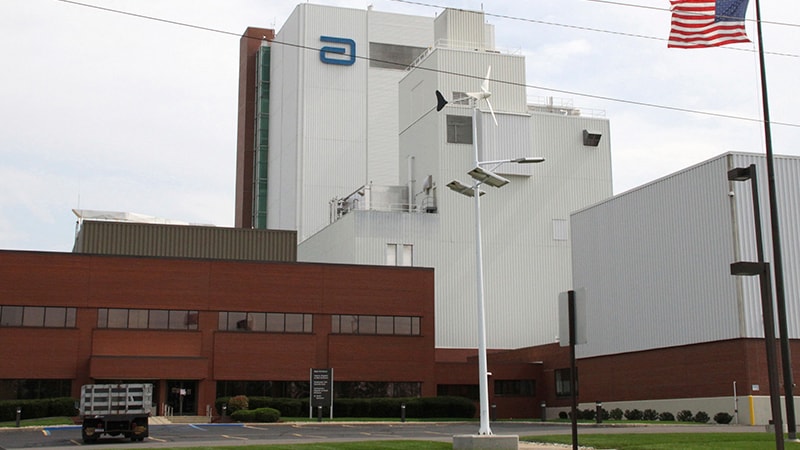WASHINGTON (AP) — At the center of the nationwide baby formula shortage is a single factory: Abbott Nutrition’s plant that has been closed for more than three months because of contamination problems.
On Monday, U.S. officials announced a deal with Abbott that paves the way to restart production at the Sturgis, Michigan, facility, the largest in the U.S. and source of leading brands like Similac.
But it’s not yet clear how soon the site will be up and running. And even bigger questions remain unanswered, including what caused the contamination and whether U.S. regulators could have alleviated the current formula shortage by stepping in sooner. The plant shutdown exacerbated ongoing supply chain problems among U.S. formula makers.
WHAT CAUSED THE SHUTDOWN?
In mid-February, Abbott announced it was recalling various lots of three powdered infant formulas from the plant, after federal officials began investigating rare bacterial infections in four babies who were fed formula. Two of the infants died. But it’s not certain the bacteria came from the plant; strains found at the plant didn’t match the two available samples from the babies.
The company halted production while Food and Drug Administration inspectors conducted a six-week investigation of the plant.
A preliminary report released in March found traces of a bacteria — cronobacter— on several surfaces throughout the plant, though not in areas used to make the powder. Plant records showed Abbott had detected the bacteria eight times in its products or facility since 2019.
Inspectors also flagged other problems, including standing water on the floor and employees who didn’t properly sanitize their hands.
WHAT IS CRONOBACTER?
The bacteria occurs naturally in soil, water and other parts of the environment. Infections with cronobacter are rare but can be fatal in babies. Almost all previous outbreaks in the U.S. have been linked to powdered baby formulas, which don’t undergo the same high temperatures used to kill germs in many other foods.
Sometimes the bacteria can get into powdered formula after its opened at home if a dirty scoop is used or it is mixed with water that’s contaminated with the germ, according to the Centers for Disease Control and Prevention.
Cronobacter typically causes fever in infants and can sometimes lead to dangerous blood infections or swelling of the brain.
The four reported illnesses were in Minnesota, Ohio and Texas between September and January.
WHAT ROLE DID ABBOTT’S FORMULA PLAY IN THE ILLNESSES?
It’s still not yet clear. The FDA hasn’t released a final ruling on the problems at the plant and whether they are linked to the infections.
“There are many factors involved in this ongoing investigation and we’re just not in a position to make any definitive statement,” FDA Commissioner Robert Califf said Monday.
Food safety experts say the case underscores the challenges of tracing foodborne illnesses.
Because there were only two samples collected from the four cases, “Right from the get-go we were limited in our ability,” to link the baby formula to the illnesses, said the FDA’s food director Susan Mayne. “We simply don’t have the evidence to demonstrate that causality.”
Abbot says the lack of a strain match indicates “there is no evidence to link our formulas to these infant illnesses.”
SHOULD THE FDA HAVE STEPPED IN SOONER?
The FDA is facing intense scrutiny about what steps it took — and didn’t — in the months before the recall.
FDA inspectors visited the factory in late September for a routine inspection, around the time that the first bacterial infection was reported in Minnesota.
Although inspectors uncovered several violations— including standing water and unsanitary conditions — they didn’t find any bacteria and let the plant stay open. It’s unclear if inspectors were even aware of the first reported illness.
After three more cases were reported, the FDA returned to the plant in January and detected the bacteria.
The FDA mainly focuses on assuring the safety of the food supply, with extra regulations and standards on foods for babies and children. But former FDA officials say the agency is supposed to consider potential shortages that result from shutting down plants.
In previous cases, the FDA has worked with companies to shift production to other facilities or find alternative supplies.
The FDA is doing that now under a new policy that eases imports of baby formula from foreign manufacturers. But both the agency and the White House are facing questions on why that step wasn’t taken sooner.
“We always believe we can do better in terms of the time frame,” Califf said.
Rep. Rosa DeLauro, D-Conn., reported last month that a whistleblower had contacted the FDA in October with allegations about unsafe conditions and practices at the plant, including falsifying plant records and failing to properly test formula for contamination. She said the FDA did not interview the whistleblower until late December. Califf is scheduled to answer questions from DeLauro and other lawmakers on Thursday.
WHEN WILL THE PLANT RESTART PRODUCTION?
Both the FDA and Abbott say they are working as quickly as possible to restart manufacturing at the plant. But FDA officials say the onus is on Abbott to demonstrate its Michigan plant meets rigorous safety standards.
Former FDA officials say fixing the type of problems uncovered at Abbott’s plant takes time, and infant formula facilities receive more scrutiny than other food types. Companies need to exhaustively clean the facility and equipment, retrain staff, repeatedly test and document that there is no contamination.
Even after the facility opens, Abbott says it will take eight-to-ten weeks before new products start shipping to stores. The company continues to produce baby formula at its other plants in the U.S. and overseas.
Follow Matthew Perrone on Twitter: @AP_FDAwriter
The Associated Press Health and Science Department receives support from the Howard Hughes Medical Institute’s Department of Science Education. The AP is solely responsible for all content.
Source: Read Full Article
